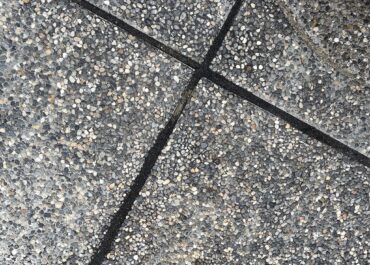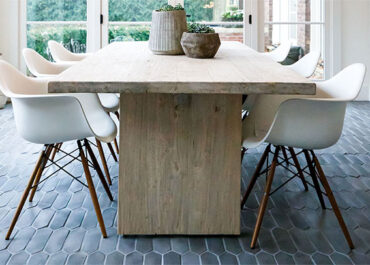
In recent years, the hardscape industry has been taken by assault by a new trend: porcelain pavers. Many homeowners and professionals in the hardscape business have started realizing the potential of this material. They can even rival the old time king of pavers: concrete pavers. So what exactly are porcelain pavers, and why are they so good?
Pavers, also known as paving stones, are perhaps the oldest hardscape material known to man. They are being used for centuries across many cultures. And that’s for good reason. Pavers are very resistant individually and, when put together, they create an incredibly versatile system that can withstand even the heaviest weights.
Historically, brick, concrete and natural stone have been the most popular materials for pavers. Concrete pavers have been dominating the market for years due to their versatility, low cost and resistance. But porcelain pavers have come to change the game entirely.
So what makes porcelain such a good material for a paver? What are the applications, maintenance and cost of porcelain pavers? Let’s start answering all those questions.
How Porcelain Pavers are Made?
To understand porcelain pavers, we have to first talk about porcelain in general.
Porcelain is perhaps better known for its tableware applications, in relatively delicate and intricate aspect, so it might sound strange to think of it as a robust paver material. But it all comes down to some slight changes.
The ingredients and porcelain pavers are: high quality clay, quartzitic sand, feldspar and kaoline.
The process of fabrication starts by mixing all these ingredients with cold water. The aggregate is mixed to reduced to extremely fine particles, becoming a form of mud in the process. It becomes as smooth and fine as a lubricant.
This mud is then left to dry until there’s only about 6% of water in its composition. This drying is done is separate silos, one for each type of porcelain.
By “type of porcelain” we mean mixtures of different quantities of each substance. The key to a good porcelain is a precise mixture of different “blends” to create the perfect material for the specific products that’s being manufactured.
With the right mixture done, the aggregate is then pressed into a mold. These molds can be designed to simulate the look and texture of virtually any natural stone there is. After being submitted to extreme pressure and a final drying process, the resulting material becomes harder and more cohesive.
At this moment, the porcelain can receive a treatment to have a specific image pattern and color. This can be done by a roller printer or even an inkjet printing process.
With all the preparations done, it is finally time to cook the porcelain in a kiln that can reach temperatures as high as 2,2000 °F. This cooking process, as well as the following cooling process, are extremely controlled and key to the quality of the final product.
Why are Porcelain Pavers so Good?
Aside from their high resistance, one of the most important characteristics of porcelain pavers, and what gives them an edge over the most traditional choices, is their non-porosity.
Other types of pavers are porous, which means they can absorb water and other fluids. For that reason, the maintenance of these pavers is more intricate, since they need to be protected against the weather and spills.
This protection involves the sealing of the paver installation, a process that can be expensive and time-consuming, albeit necessary.
Porcelain pavers however do not have that problem. Since they are non-porous and naturally impervious to fluid absorption, the sealing can be dispensed.
Even the cleaning itself is easier with porcelain pavers. A regular sweep to keep them free of leaves and debris, followed by a mopping with warm water and pH-neutral cleaning solutions once a month, is more than enough to keep them in pristine quality.
And since porcelain pavers can be molded to simulate the aesthetic appeal of any other products, you won’t be sacrificing functionality over looks. Porcelain pavers are one of the most aesthetic pleasing materials in the market, sure to have a design that can perfectly any hardscape project out there.
Porcelain paver also deliver in the cost-effective department, costing only $7- $9 per square foot.
Applications and Installation
Porcelain pavers can be used virtually anywhere. In fact, they are so resistant that they are often the paver choice for factory flooring and high traffic areas.
They can come in two different variations of thickness: standard size (between 8 and 10 mm), and the 20 mm variation.
The standard size is better suited for interior applications, as it can be smaller and easier to work with. The 20 mm variation is the bigger and heavier version of porcelain pavers, usually used for outside flooring.
As for the installation process, porcelain pavers are not that easy to work with in comparison to the most traditional choices of pavers. Brick, concrete, and even some forms of natural stone, can be easily installed on a DIY perspective.
Porcelain, however, can be a little tricky, especially for people who don’t have experience installing pavers. They are heavier and harder to work with by yourself. The best course of action is always to ask for a professional in the hardscape business to help you with your installation.

Acquiring Porcelain Pavers
So, hopefully you now understand what makes porcelain so good and why is has conquered the hearts of homeowners and professionals alike.
And speaking of professionals, as we mentioned, working closely to one in fundamental for a successful porcelain paver installation. Look for a qualified professional in your area and ask for help in acquiring and installing porcelain pavers.
And if you happen to be around our area of activity, the Sarasota and Manatee counties, in FL, why not give us a call to help you?
You can contact us right now at +1 941-210-4192 or email us at sales@eaglepavers.us. We would be happy to hear from you and help you with your porcelain paver project.




